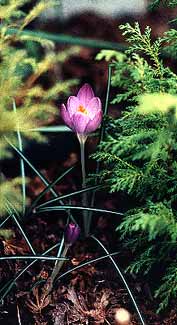 Tommasini's
Tommasini's
Lilac Crocus
"The sun is hot on my neck as I observe
The spikes of the crocus.
The smell of the earth is good.
It is apparent that there is no death."
-Edna St. Vincent Millay
1892-1950
1892-1950
 Crocus tommasinianus is named for Muzio G. Spirito de Tommasini (1794-1879), botanist & mayor of the city of Triest, shown in the little portrait at the right.
Crocus tommasinianus is named for Muzio G. Spirito de Tommasini (1794-1879), botanist & mayor of the city of Triest, shown in the little portrait at the right.This crocus is regarded one of the "Snow Crocus" species for blooming ahead of spring. In our garden it starts blooming no later than February, fast in the wake of such earliest bloomers as C. korolkowii 'Mountain Glory' & C. sieberi 'Firefly' & C. chrysanthus 'Goldilocks.' In our garden the Lilac Tommy will even in some years flowers as early as the third week of January. This wild form always flowers a little ahead of its cultivars, except for C. tommasinianus var albus which has bloomed for us as early as December & in January at latest.
C. tommasinianus reproduces rapidly by self-seeding & by corm offsets. Indeed, "tommies" naturalize with such ease that some gardeners complain of them after a few years, as the cormlets are much too tiny to ever sieve out of the soil, & wherever the tommies spread on their own, that's where they will always remain.
Personally I can't imagine them being unwelcome under any circumstance. The more they spread, they merrier they are, as they are very small, & in no way squeeze out other plantings.
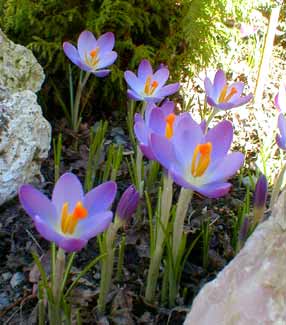 The exception to its rapidly naturalizing potential arises when there are squirrels or chipmunks or other rodents that develop a taste for them. All crocuses have a certain squirrel appeal, & self-seeded bulbs are so close to the surface they are easily detected. So some gardeners complain they cannot get a really large drift to thrive & spread.
The exception to its rapidly naturalizing potential arises when there are squirrels or chipmunks or other rodents that develop a taste for them. All crocuses have a certain squirrel appeal, & self-seeded bulbs are so close to the surface they are easily detected. So some gardeners complain they cannot get a really large drift to thrive & spread.In such cases it is best to not go to war with chipmunks or squirrels, who deserve to be regarded as welcome visitors, as much so as birds. It's better to adjust one's gardening techniques & choices around such pleasant animals, rather than resenting their activities. Gardening should increase one's love of a broader element of nature, rather than reducing gardeners to nature-haters.
Planting the bulbs to four inches instead of two or three, & fertilizing the area with bloodmeal which distresses squirrels, might be all one needs to do to insure the survival of sufficient numbers of tommies.
The second proviso that limits the spread of such early-blooming crocuses is their pollination requirement, which is done exclusively by insects. Crocuses grown in shadier conditions may flower pretty well but without being fully opened for many hours or days, hence can go unpollinated since early-season bees won't fight to get the petals opened.
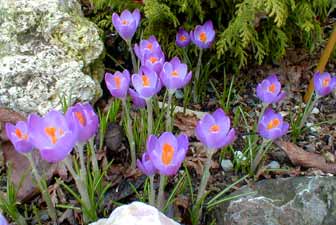 Blooming so early that it is still winter may mean the Tommies are waiting for bees to get to them in places where bees won't be up & busy until a month too late; plus, non-organic gardeners may be killing off most of the pollinators. Putting up bee-hotels for small bee species such as mason bees, & never using pesticides ever, will generally repair any lack of pollinators.
Blooming so early that it is still winter may mean the Tommies are waiting for bees to get to them in places where bees won't be up & busy until a month too late; plus, non-organic gardeners may be killing off most of the pollinators. Putting up bee-hotels for small bee species such as mason bees, & never using pesticides ever, will generally repair any lack of pollinators.This one drift is the natural form of Tommasini's crocus, a mid-sized very brightly colored lilac with hues of silveriness that render it so luminiscent it seems like it ought to glow in the dark. Selected, named varieties of Tommies will not necessarily grow true from seed, but will be pretty however their seedlings turn out; the purely wild form does seed true to itself, except when grown in proximity of named cultivars. We have named varieties of tommies elsewhere in the gardens, & they are quite some distance from the wild-form Tommies.
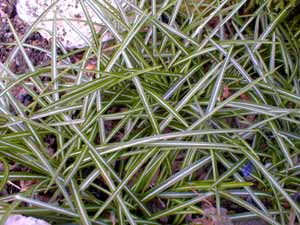 Corms from different sources produce crocuses of varying size or depth of color, but they always have the shimmering quality that sets them apart from other species. It has a sturdy stem not at all inclined to tip over on a rainy day as do some larger but weaker-stemmed species.
Corms from different sources produce crocuses of varying size or depth of color, but they always have the shimmering quality that sets them apart from other species. It has a sturdy stem not at all inclined to tip over on a rainy day as do some larger but weaker-stemmed species.Its natural range includes Hungary & Bulgaria & it is very cold-hardy. It likes full sun in well-draining loamy soil, but adapts to partial shade if it has to. Our wild ones are underneath the Lion's Head Maple, & winding about a tiny dwarf evergreen, Chamaecyparis pisifera 'Cream Ball.' In this semi-shady area they have bloomed & spread with exceeding success.
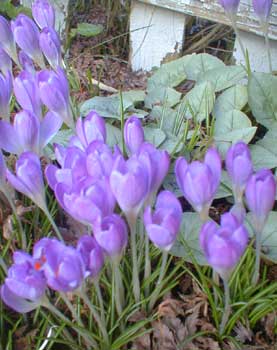 In Autumn 2004 we added another two-dozen or so bulbs to the already-healthy drift of wild tommies, extending their spread around the base of the lion's-head maple. Since it blooms when the Lion's Head is still leafless, Crocus de Tommasi gets the sun it needs when it needs it.
In Autumn 2004 we added another two-dozen or so bulbs to the already-healthy drift of wild tommies, extending their spread around the base of the lion's-head maple. Since it blooms when the Lion's Head is still leafless, Crocus de Tommasi gets the sun it needs when it needs it.In spring 2005 the newer wild tommies were in full show by the end of the first week of February, whereas the longer established tommies appeared three weeks later. In 2006 however, they did not have this staggered timing, but were in huge bud before January's end & blooming splendidly in February.
The final photo (here at the left) shows a few of these tommies in early February 2006, with lingering leaves of autumn-blooming Cyclamen hederifolium 'White Cloud' in the background.
Because Tomasini's crocus is smallish it does not prefer to be planted in turf, being too easily overwhelmed by taller sods; although if it is thin grass, it'll do well. If their numbers are sufficient, they can overcome the possibility of being hidden by sod, & bloom so early that there is no threat of mowing interfering with them.
The post-bloom striped leaves can alone be very appealing. For some varieties the grass stands very upright, but for this wild tommy, its grass nearly lies flat. The second-to-last picture on the page shows late-March post-bloom grass at the foot of the 'Cream Ball' evergreen, all woven into a very low mat. One of our other tommies, 'Ruby Giant,' has much more upright grass, while 'Whitewell Purple' is about halfway in between upright & low-lying. In time the crocus-grass will vanish into summer dormancy.